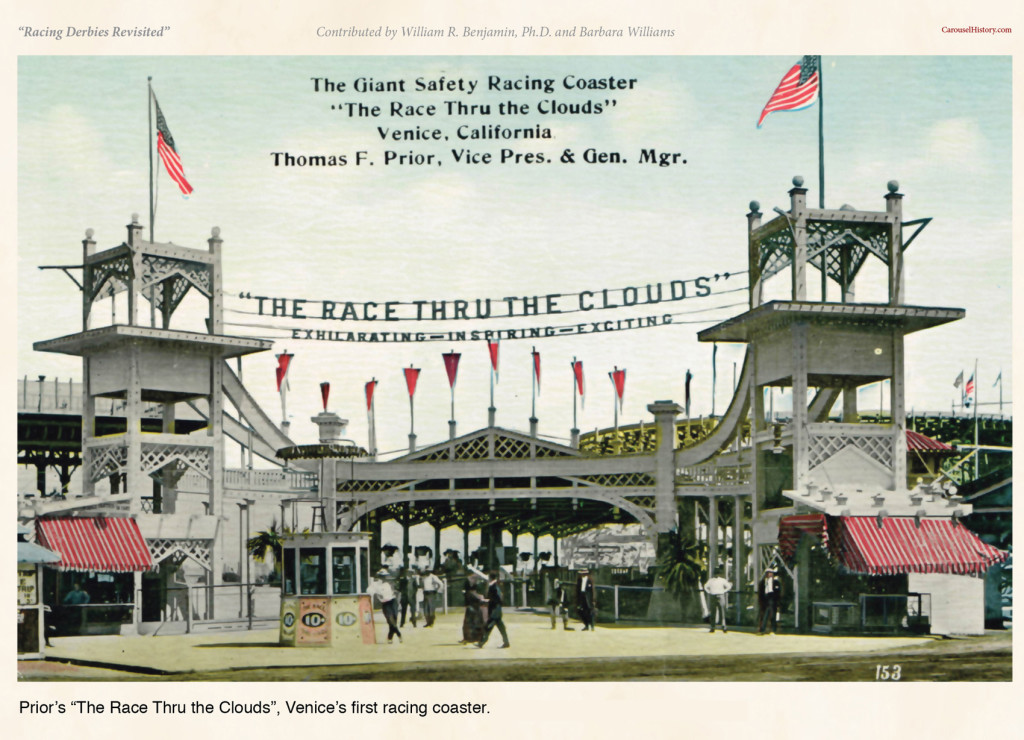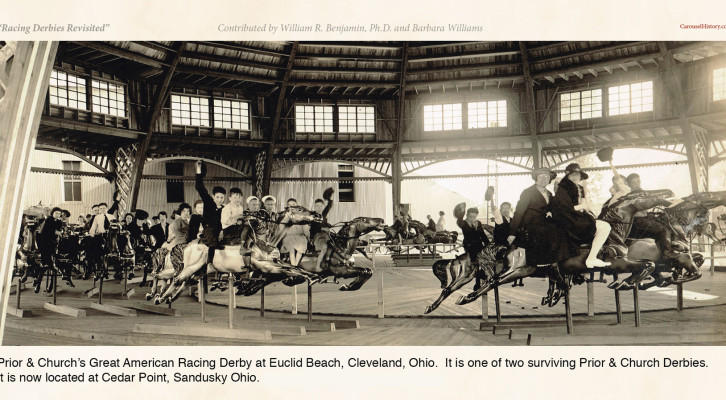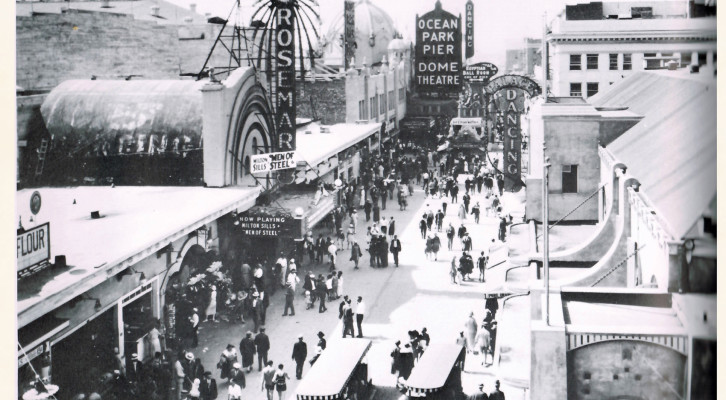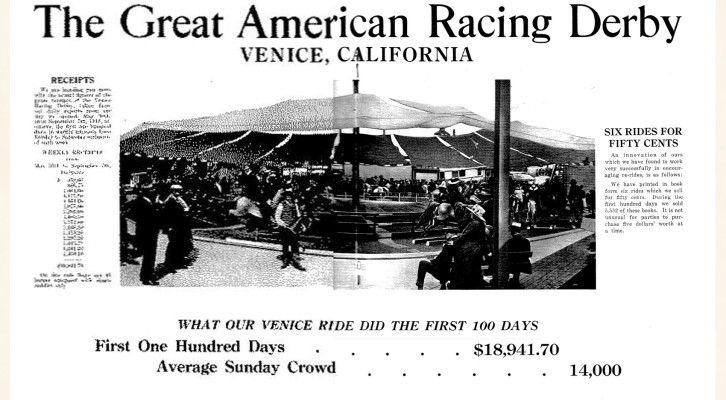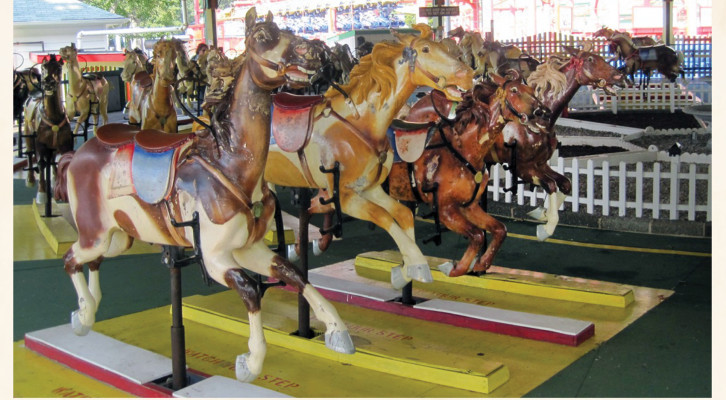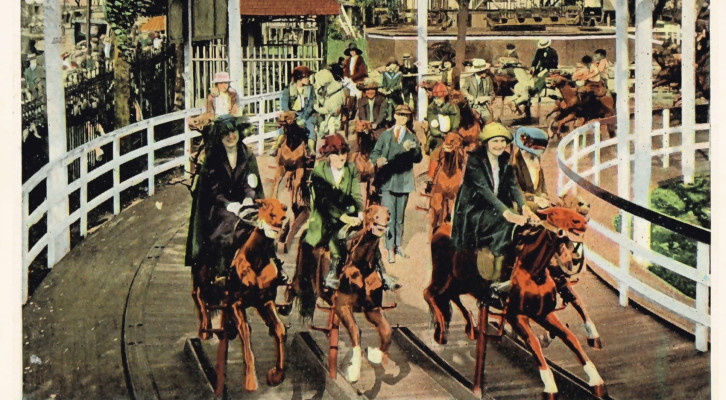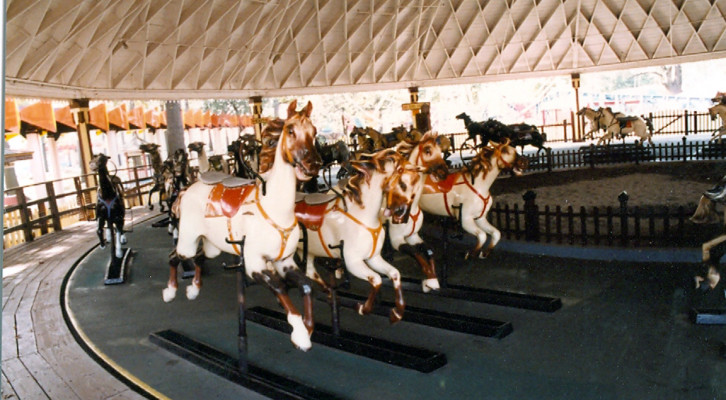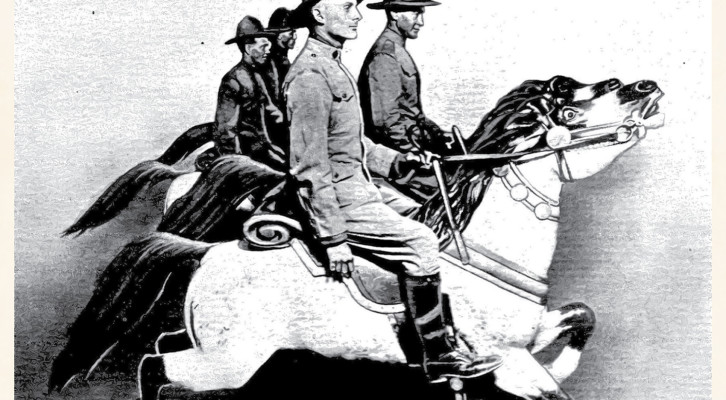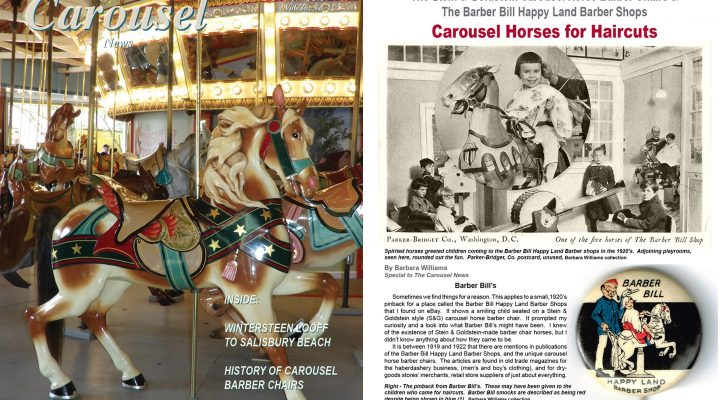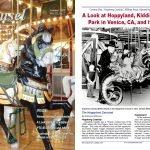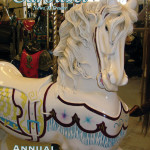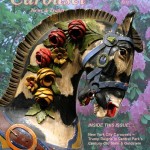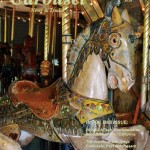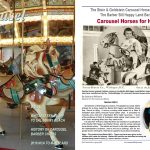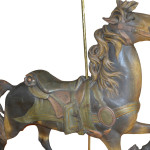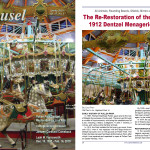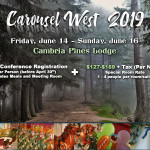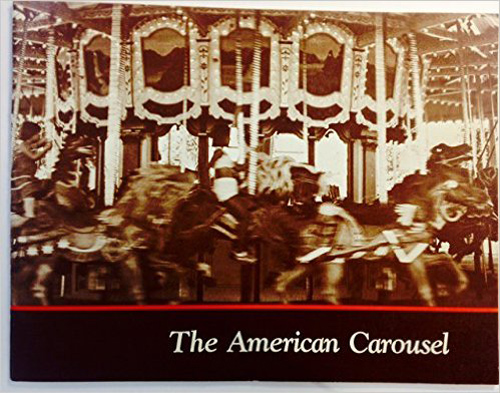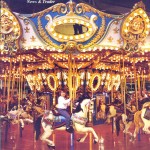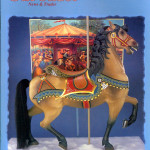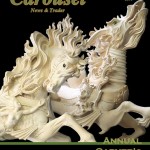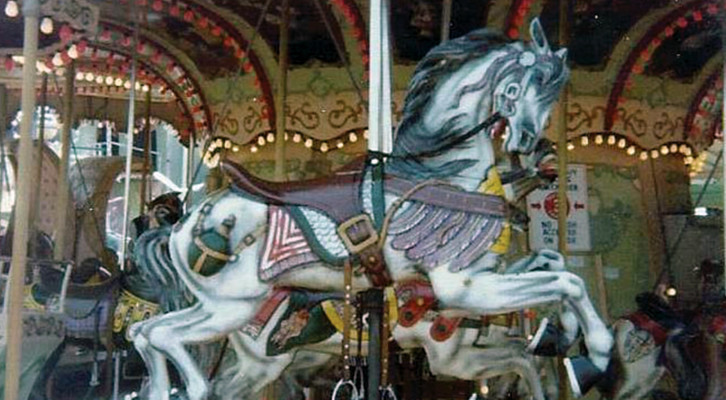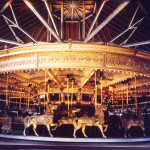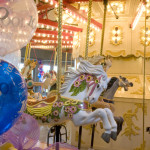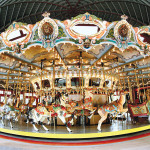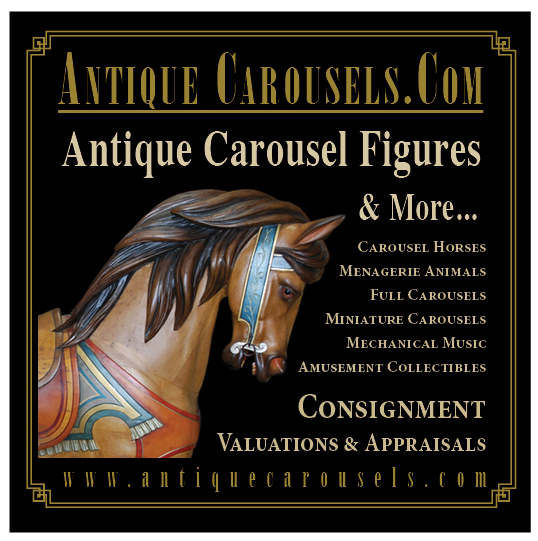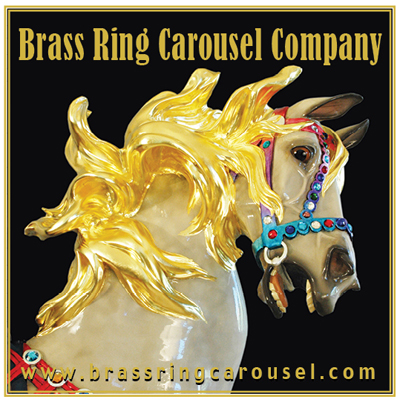Racing Derbies Revisited – Part 1 – Introduction:
Meet T. W. Prior and F. A. Church. Together they patent the Great American Racing Derby, Dec. 30, 1913

Prior & Church’s Great American Racing Derby at Euclid Beach, Cleveland, Ohio. It is one of two surviving Prior & Church Derbies. It is now located at Cedar Point, Sandusky OH.
Racing Derbies Revisited
Contributed by William R. Benjamin, Ph.D. and Barbara Williams
Introduction
On December 30, 1913 T.W. Prior and F.A. Church were granted a patent (1) for an amusement device that they subsequently called a “Great American Racing Derby”. In contrast to carousels, the horses, mounted 4-abreast, were installed so that they moved forward and backward and “raced” against each other. “Winners” were given a ticket for a free ride. The first Great American Racing Derby was dedicated at Ocean Park, California on December 10, 1916 (2).
Several articles have been published documenting various aspects of the history of Racing Derbies. Most notable of these is a comprehensive history of Prior & Church Great American Racing Derbies by Jim Abbate published in 2012(3). In this article we build upon the research that had been published by Abbate and also by Jeffrey Stanton (4).
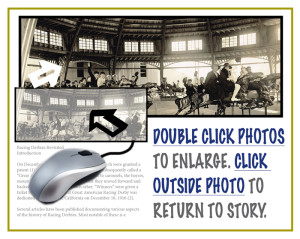 We begin by examining the backgrounds and relationship of Tom Prior and Fred Church prior to their partnership that culminated in the building of the first two Great American Racing Derbies at Ocean Park and Venice, California. We present an in-depth study of Derbies in three different areas/locations; Ocean Park and Venice, California, Galveston Beach, Texas, and Coney Island, Brooklyn, New York, with an emphasis on the unique Venice, Prior & Church’s home-base of operation. During the course of our research we came across earlier and later derby-like rides which may have influenced, or been influenced by Prior & Church’s Racing Derbies; we have included a description of those. Prior & Church seemed to use at least 3 different suppliers for their derby horses, all with distinct styles. We examine the likely carvers for these horses. Finally, using the information from Abbate’s article and other references, we include a summary of all of the known Great American Racing Derbies that were placed at various locations.
We begin by examining the backgrounds and relationship of Tom Prior and Fred Church prior to their partnership that culminated in the building of the first two Great American Racing Derbies at Ocean Park and Venice, California. We present an in-depth study of Derbies in three different areas/locations; Ocean Park and Venice, California, Galveston Beach, Texas, and Coney Island, Brooklyn, New York, with an emphasis on the unique Venice, Prior & Church’s home-base of operation. During the course of our research we came across earlier and later derby-like rides which may have influenced, or been influenced by Prior & Church’s Racing Derbies; we have included a description of those. Prior & Church seemed to use at least 3 different suppliers for their derby horses, all with distinct styles. We examine the likely carvers for these horses. Finally, using the information from Abbate’s article and other references, we include a summary of all of the known Great American Racing Derbies that were placed at various locations.
Background on Prior & Church
The complete story of how Tom Prior and Fred Church met and conceived of their business enterprises isn’t known. However, as shown below, it is clear that the two men met in Chicago before 1910. Their quite different career paths prior to forming The Great American Racing Derby, Co. provides insight into the talents that each one brought to the business.
Thomas Walworth Prior, born on October 27, 1862 in East Boston, Massachusetts began his career as a newspaper artist and illustrator for the Chicago Daily News in the 1870’s and for the Chicago Times beginning in 1885 (5). He left the newspaper in 1886 to become the treasurer of the Chicago Opera house (6). Over the next 24 years, he became well established and broadly known in the Chicago entertainment and amusement fields.
We don’t know precisely how long Prior served in each of these positions but the range of jobs that he held is quite extensive. The year(s) shown are inclusive of references found.
- Manager of Chicago Opera House, 1886-1894 (7)
- Theatrical Manager of Trocadero, 1893 (8)
- Leased the Brunswick Billiard Hall to open “The Empire” Variety Theater, 1891(9)
- Officer of Ice Rink Company of Chicago which managed the Ice Palace, 1891(6)
- Manager of Digby Bell’s Opera Company, company goes bankrupt, 1892 (10)
- Manager of Herrmann’s New York Theater, 1893 (11)
- Manager of Schiller Theater, 1894-1895+ (12)
- An entry into the amusement business; noted to “be arranging for building a place of amusement near the south side shore of the lake”, 1896 (13)
- Head of Press Bureau of White City, Chicago, IL, 1906 (14)
- Director of Publicity for Riverview Park, 1907 (15)
- Director of Amusements for Forest Park Fair Grounds and Amusement Company, 1908(16). Sold in 1910(17). Astonishingly, 200 personal injury lawsuits were filed in one day against the company on July 31, 1909(18). The Forest Park Fair Grounds and Amusement Company filed for bankruptcy in 1915(19).
It is interesting to note that even though Prior was primarily involved in the above businesses, in 1901, he was a co-inventor with Matthew Prior on a patent with claims that showed an improvement on Eli Whitney’s cotton gin. It was estimated that the improvement would increase the profit on ginning a pound of cotton by up to 1 and ½ cents per pound(20,21).
Tom Prior married Annie J. Pond on July 26, 1883. They had one son, Frank M. Prior, born January 1885 (22). The 1910 Census also shows that Fred Church was living in the same residence as the family of Tom Prior. Thus, they clearly had met and were formulating plans for future endeavors by this time.
Frederick A Church was born in Canada in 1879 and arrived in the United States in 1897 (22). In 1910, Church was employed by a Chicago company that designed and fabricated replacement parts for rides. Church had an engineering background(24).
Prior moved to Venice, CA in 1911 and Church most likely accompanied him at that time to begin their business building roller coasters and Racing Derbies. The first amusement that they built was an aerial railway (racing coaster) known as “The Race Thru the Clouds” (6).
We have found evidence that Prior &Church built at least 18 Racing Derbies, unless some were relocations. They also built approximately ten coasters, half of them together before Tom Prior’s death(24). After Tom Prior’s death on September 22, 1918 (25), Frank M. Prior, Tom’s son, became Church’s partner (26). Records suggest that after Tom Prior’s death, Tom’s wife Annie married his partner Frank Church. Santa Monica City Directories from 1921-1931 show Frank and Annie J. Church residing in the city.
There are two surviving Prior & Church Great American Racing Derbies, one at Cedar Point, Sandusky, OH, and one at Playland, Rye, NY. There are also two surviving Church coasters, the “Giant Dipper” at Santa Cruz and the coaster at Mission Beach in San Diego, California. Both of them are on the National Register of Historic Places(27).
California
California, The Golden State – so nicknamed for the gold found in its soil, its fields of golden poppies, and the breathtaking golden sunsets over the Pacific Ocean. The “Gold” also refers to the wealth of the state generated by the sought-after, temperate year-round climate. Nowhere else does this apply more than at the coast in southern California where, in the early 20th century, entrepreneurs turned vast amounts of useless, sea-side marsh land in the Santa Monica bay area into thriving communities that sat adjacent to enormous playgrounds – the Venice, Ocean Park and Santa Monica amusement piers. Fun for all was on a year-round basis with winter requiring little more than an extra wrap at times. Fun-seekers, risk-takers, families and individuals came to play and frolic. It truly was a land of opportunity and heaven for those who liked a lot of sunshine.
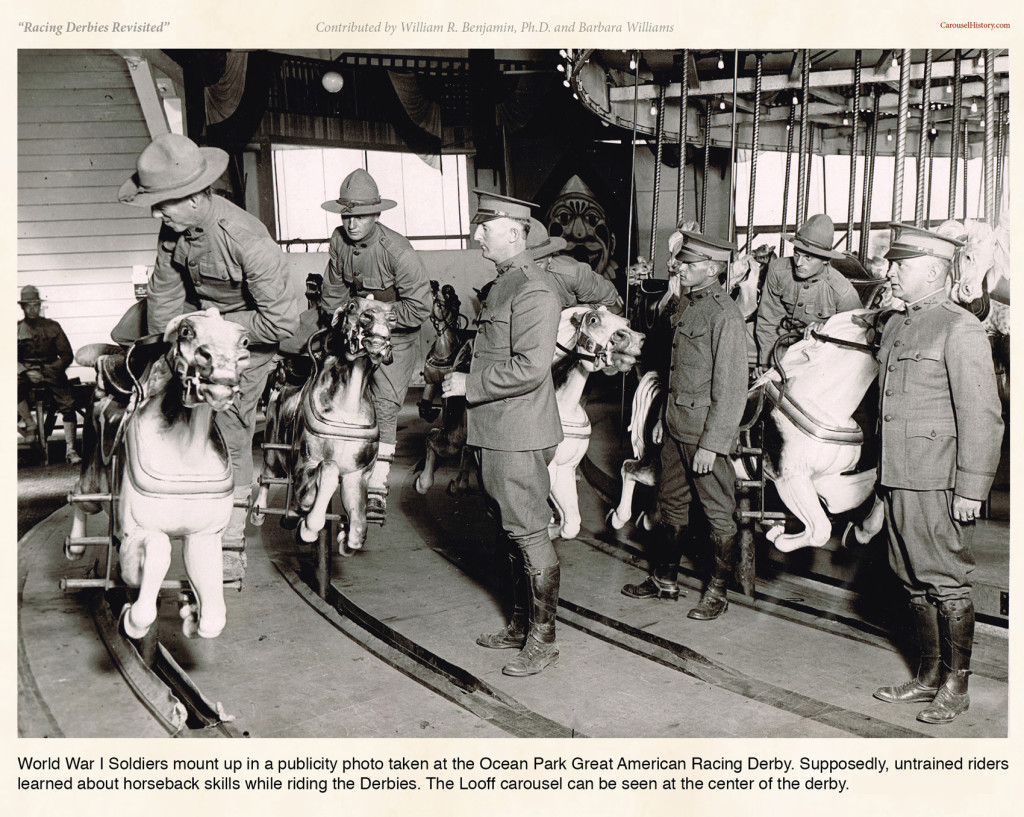
World War I Soldiers mount up in a publicity photo taken at the Ocean Park Great American Racing Derby. Supposedly, untrained riders learned about horseback skills while riding the Derbies. The Looff carousel can be seen at the center of the derby.
Racing Derbies Revisited….
Contributed by William R. Benjamin, Ph.D. and Barbara Williams
<<< PREVIOUS – NEXT >>>
PART 1 – PART 2 – PART 3 –
PART 4 – PART 5 – PART 6 –
SUMMARY OF RIDES
< PREV – PART 1 – PART 2 – PART 3 – PART 4 – PART 5 – PART 6 – RIDES – NEXT >

